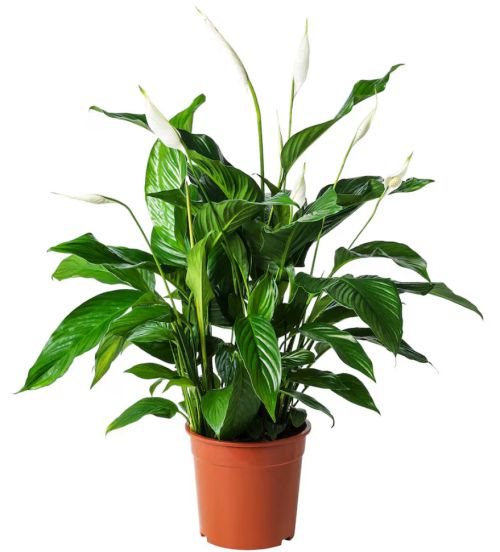Peace Lily (Spathiphyllum)
Last
updated: August 3,
2025
Care Sheet List
The Peace
Lily is a classic and elegant houseplant, admired for its glossy, dark
green
leaves and distinctive white, spoon-shaped flowers (spathes). It's a
forgiving
plant that is excellent at communicating its needs, famously drooping
its
leaves when thirsty.
Lighting
- Ideal: Peace Lilies
thrive in low to medium indirect light. A little
direct sun in the early morning is perfectly fine and not strong enough
to burn the leaves. The diffuse, indirect light for the rest of the day
is exactly what they need to grow and bloom.
- Benefits: This type of
light encourages consistent growth and flowering.
- Avoid: While your
current location is great, it's important to remember that direct,
harsh midday or afternoon sun will easily scorch the leaves, causing
them to turn yellow and brown.
Watering
Routine
With a large
plant in an 18-20" pot, watering will be less frequent than for a
smaller
one, but it is still the most critical aspect of care.
- Frequency: Water when the top
2-3 inches of soil feel dry to the touch. You can also wait
for a key sign: the leaves will begin to slightly droop. This is a very
clear signal that the plant is thirsty.
- Method: Water
thoroughly until you see water draining from the bottom of the pot. A
large pot like yours may require several gallons of water to saturate
the root ball completely.
- Important: Discard any
excess water from the saucer. Peace Lilies do not like to sit in
standing water.
- Seasonality: Since your
plant is outdoors, you will likely need to water more frequently during
the warmer, drier months than you would if it were indoors. Monitor it
more closely during heatwaves. In fall and winter, as temperatures drop
and growth slows, reduce watering frequency.
Fertilizer
Requirements
A large,
mature Peace Lily needs regular feeding to support its size and
continuous
flowering.
- Schedule: Fertilize
during its active growing season, from spring through early
fall. Once every 2-4 weeks is sufficient.
- Type: Use a balanced
liquid houseplant fertilizer.
- Commercial Recommendation: Miracle-Gro
Indoor Plant Food (Liquid) or Schultz Liquid Plant
Food are easily available options. Dilute these commercial concentrates to achieve approximately 100-200 ppm N in your final solution. This is often equivalent to using them at "full strength" as directed on the package.
- DIY Fertilizer Suggestion: For robust growth and continuous flowering, use your homemade 1-1-1 liquid fertilizer concentrate (Balanced) or the 1-2-1 liquid fertilizer concentrate (High Phosphorus).
- For 1-1-1 concentrate (10,000 ppm N): Apply at a "Moderate to Heavy Feeding" rate, using 10 ml to 20 ml per 1 liter of water (resulting in ~100-200 ppm N). See recipe details.
- For 1-2-1 concentrate (10,000 ppm N): Apply at a "Moderate to Heavy Feeding" rate, using 10 ml to 20 ml per 1 liter of water (resulting in ~100-200 ppm N, 200-400 P₂O₅, 100-200 K₂O). See recipe details.
- Avoid: Do not
fertilize in late fall and winter.
Misting
Requirements
Peace Lilies
are tropical plants that appreciate high humidity.
- Recommended: Your outdoor
location likely provides adequate humidity for much of the year.
However, if you notice the leaf tips turning brown or crispy, it can be
a sign of low humidity.
- Methods:
- Misting the
foliage with a spray bottle is a good occasional practice, especially
on hot, dry days.
- The large pot
size and amount of foliage will also help create its own humid
microclimate.
Pot Size
and Soil Type
- Pot Size: Your 18-20" pot
is a perfect size for a large, mature Peace Lily. It has plenty of room
to grow and thrive. Peace Lilies don't mind being somewhat root-bound,
but for a plant of this size, it may benefit from having its soil
refreshed every couple of years.
- Soil Type: Use a well-draining,
all-purpose potting mix that is rich in organic matter. A
standard indoor potting mix is suitable.
- Repotting/Soil
Refresh: Instead of a
full repot, which can be challenging with a plant this large, you can
"refresh" the soil. Carefully scrape away the top 2-3 inches of old
soil and replace it with fresh potting mix. This provides new nutrients
and aeration. If you do choose to fully repot, remember to choose a pot
only 2 inches larger and ensure it has ample drainage holes.
Other
Important Care Notes:
- Cleaning: The large,
glossy leaves of your Peace Lily will collect dust outdoors. Regularly
wipe them gently with a soft, damp cloth to keep them clean and to
allow for better light absorption.
- Flowering: To encourage
more flowers, ensure it receives consistent, bright indirect light and
a regular feeding schedule during the growing season.
- Toxicity: Keep out of
reach of pets and small children, as Peace Lilies are considered toxic
if ingested.
- Winter: Given your
location you will need to bring your Peace Lily indoors before
the first frost, as it is not cold hardy.


